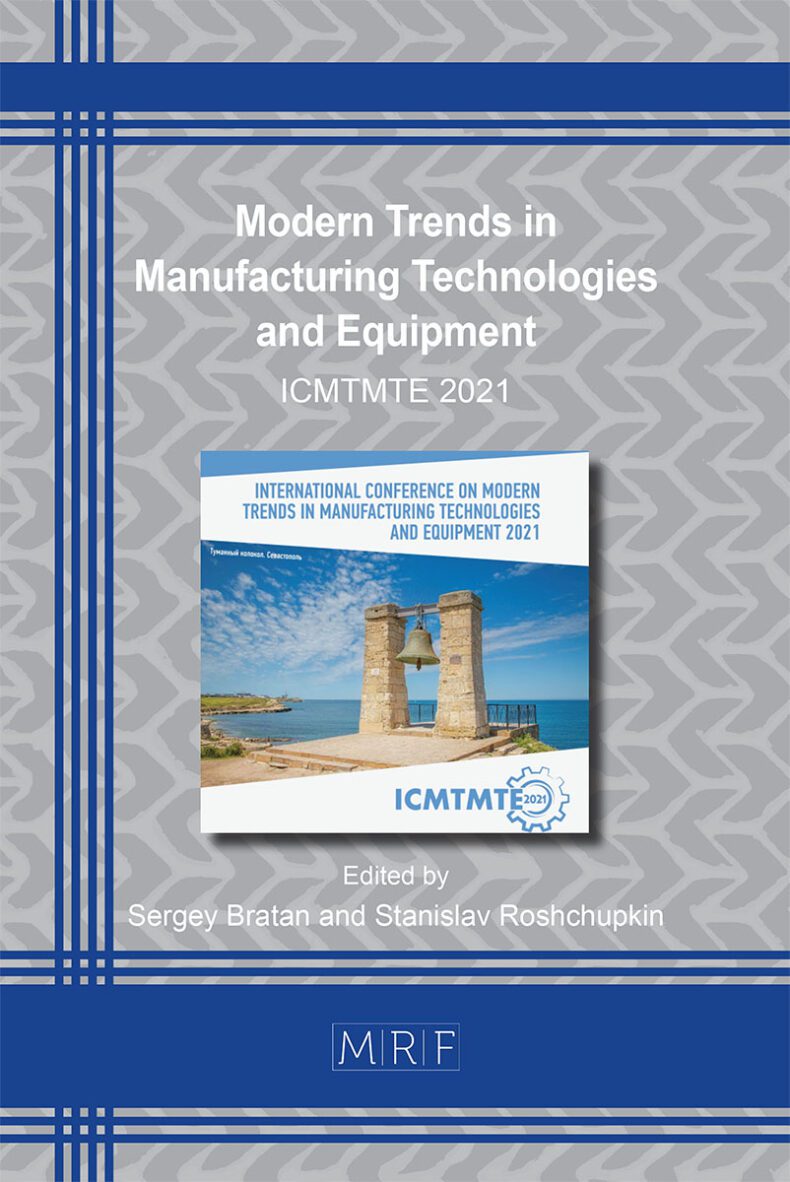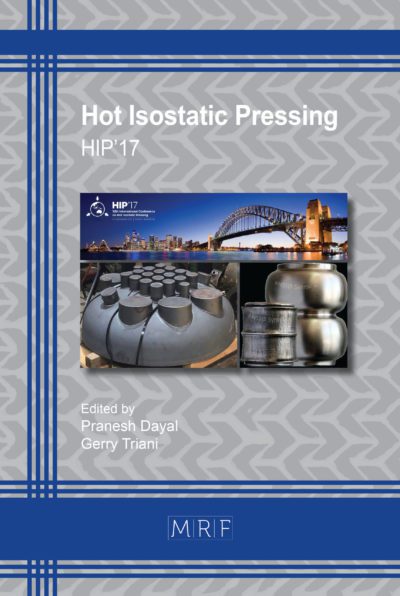Analysis of the Corrosion Behavior of the TiNi Alloy in the Coarse-Grained State
Anna Churakova, Elina Kayumova, Evgeni Vorobiev, Nafisul Haque
download PDFAbstract. In this work was investigate the corrosion behavior of the TiNi alloy in a coarse-grained state in inorganic field with different concentration and holding time. An increase in the concentration of the solution leads to a significant acceleration of corrosion processes in the Ti49.1Ni50.9 alloy with a high Ni content, including until the samples are completely dissolved. It was revealed that solutions of 1 M sulfuric and hydrochloric acids after a month’s exposure did not change in color and no precipitations were found, while solutions of 5 M hydrochloric and sulfuric acids acquired a violet and then green color, which is due to the predominant release of titanium ions (+4) and nickel (+2).
Keywords
Shape Memory Alloys, Corrosive Behavior, Pitting Corrosion, Gravimetric Method, Passivating and Activating Solutions, Microstructure
Published online 1/5/2022, 8 pages
Copyright © 2022 by the author(s)
Published under license by Materials Research Forum LLC., Millersville PA, USA
Citation: Anna Churakova, Elina Kayumova, Evgeni Vorobiev, Nafisul Haque, Analysis of the Corrosion Behavior of the TiNi Alloy in the Coarse-Grained State, Materials Research Proceedings, Vol. 21, pp 229-236, 2022
DOI: https://doi.org/10.21741/9781644901755-41
The article was published as article 41 of the book Modern Trends in Manufacturing Technologies and Equipment
![]() Content from this work may be used under the terms of the Creative Commons Attribution 3.0 licence. Any further distribution of this work must maintain attribution to the author(s) and the title of the work, journal citation and DOI.
Content from this work may be used under the terms of the Creative Commons Attribution 3.0 licence. Any further distribution of this work must maintain attribution to the author(s) and the title of the work, journal citation and DOI.
References
[1] K. Otsuka, X. Ren, Prog. Mater. Sci. 50 511–678 (2005). https://doi.org/10.1016/j.pmatsci.2004.10.001
[2] V. Brailovski, S. Prokoshkin, P. Terriault, F. Trochu, Shape Memory Alloys: Fundamental, Modeling and Applications (Ecole de Technologie Superieure, Quebec) 2003.
[3] G.V. Kurdyumov, L.G. Khandros, Sov. Phys. Dokl. 66 211–214 (1949).
[4] J.W. Christian, The Theory of Transformations in Metals and Alloys (Elsevier Science, Oxford) 2002. https://doi.org/10.1016/B978-008044019-4/50022-2
[5] Z.L. Xie, B. Sundqvist, H. Hanninen, J. Pietikainen, Acta Metall. Mater. 41 2283–2290 (1993). https://doi.org/10.1016/0956-7151(93)90310-O
[6] V.V. Rubanik, V.V. Klubovich, V.V. Rubanik Jr., J. Phys. IV 112 249–251 (2003). https://doi.org/10.1051/jp4:2003876
[7] S.P. Belyaev, R.F. Konopleva, I.V. Nazarkin, A.I. Razov, V.L. Solovei, V.A. Chekanov, Phys. Solid State 49 1969–1972 (2007). https://doi.org/10.1134/S1063783407100265
[8] K. Inoue, K. Enami, Y. Yamaguchi, K. Ohoyama, Y. Morii, Y. Matsuoka, K. Inoue, J. Phys. Soc. Jpn. 69 3485–3488 (2000). https://doi.org/10.1143/JPSJ.69.3485
[9] Meisner L.L.,2006 Corrosion properties of TiNi-TiAu quasi-binary cut alloys in biochemical solutions Physics and chemistry of material processing 1 78-84
[10] Ustinskaya T.N.,1987 Composition, electrochemical and protective properties of anode films on the TiNi intermetallide Electrochemistry 23 254-259
[11] Kossy G.G.,1978 Protection of metals 14(6) 662-666. https://doi.org/10.1109/TAES.1978.308691
[12] Stepanova T.P.,1978 Protection of metals 14(2) 169-171
[13] Deryagina O.G., 1980 Electrochemical behavior of anodically oxidized Ni-Ti alloys in sulfate solutions containing chlorine ions Electrochemistry 16(12) 1828-1833
[14] Tan L., 2003 Corrosion and wear – corrosion behavior of NiTi modified by plasma source ion implantation Biomaterials 24 3931-3939. https://doi.org/10.1016/S0142-9612(03)00271-0
[15] Okazaki Y., 1998 Corrosion resistance, mechanical properties, corrosion fatigue strength and cytocompatibility of new Ti alloys without Aland V Biomaterials 19 1197-1215. https://doi.org/10.1016/S0142-9612(97)00235-4
[16] Hofman A., 1996 Classes of materials used in medicine Biomaterials Science Academic Press 37-50. https://doi.org/10.1016/B978-0-08-050014-0.50007-9
[17] Shabalovskaya S.A., 2002 Surface, corrosion and biocompatibility aspects of nitinol as an implant material Bio-Medical materials and Engineering 12 69-109
[18] Liu Chenglong, 2006 In vitro electrochemical corrosion behaviour of functionally graded diamound-like carbon coatings on biomedical Nitinol alloy Thin Solid Films 496 457-462. https://doi.org/10.1016/j.tsf.2005.09.109
[19] Shevchenko N., 2004 Studies of surface modified NiTi alloy Applied Surface Science 235 126-131. https://doi.org/10.1016/j.apsusc.2004.05.273
[20] Vandenkerckhove R., 2004 Corrosion behaviour of a superelastic Ni-Ti alloys Materials Science and Engineering 378 532-536. https://doi.org/10.1016/j.msea.2003.11.072
[21] Denton M., 2005 Corrosion evaluation of wear tested nitinol wire Materials Science and Engineering 25 276-281. https://doi.org/10.1016/j.msec.2004.12.009
[22] Xiao Xu, 2004 Shock synthesis and characterization of nanostructured NITINOL alloy Materials Science and Engineering A 384 194-201. https://doi.org/10.1016/S0921-5093(04)00812-3
[23] Primak O., 2005 Morphological characterization and vitro biocompatibility of a porous nickel-titanium alloy Biomaterials 26 5801-580. https://doi.org/10.1016/j.biomaterials.2005.02.029

































